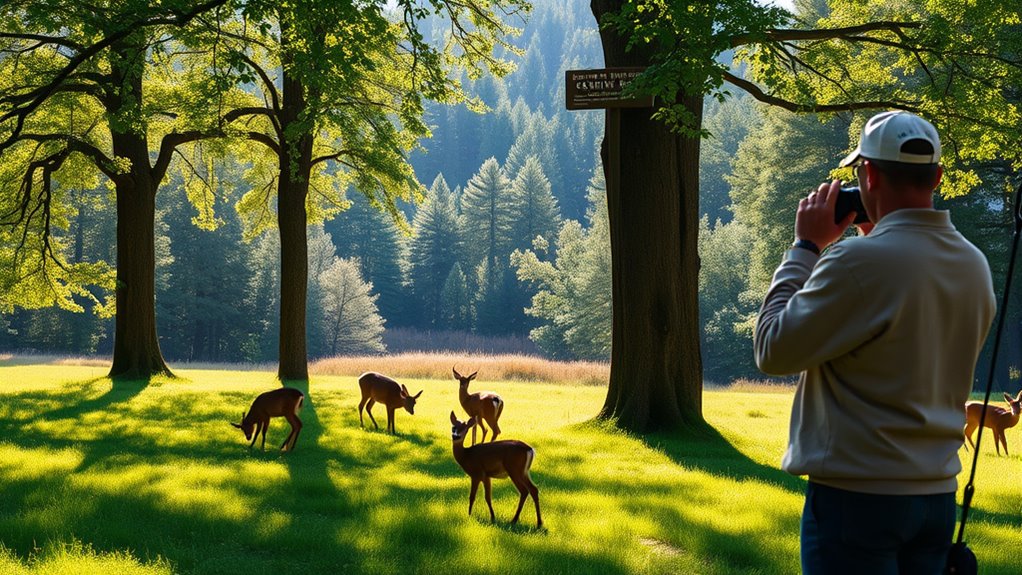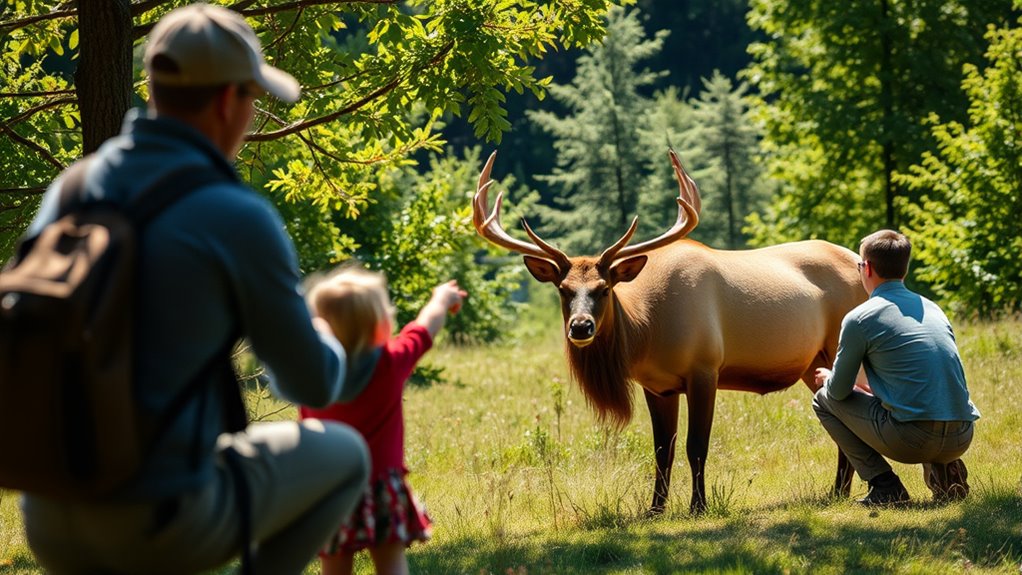When viewing wildlife in Great Smoky Mountains National Park, respect the animals and their habitats. Keep at least 50 yards away from large animals to safeguard both your safety and theirs. Avoid feeding wildlife, as it can lead to aggressive behavior. Use binoculars for a closer look and remember to practice patience while photographing. By following these guidelines, you contribute to conservation efforts and enjoy a more enriching experience. There’s plenty more to discover about responsible wildlife interactions.
Key Takeaways
- Maintain a safe distance of at least 50 yards from large animals to ensure safety for both wildlife and visitors.
- Use binoculars or zoom lenses for viewing to avoid disturbing animals and to reduce stress on wildlife.
- Avoid feeding wildlife to prevent dependence on human food and to preserve their natural foraging behaviors.
- Follow Leave No Trace principles by carrying out all belongings and minimizing your impact on the environment.
- Practice patience and respect during wildlife encounters to enhance your experience and promote conservation awareness.

When you venture into the great outdoors to observe wildlife, it’s essential to respect both the animals and their habitats. The Great Smoky Mountains National Park is home to diverse species, and your experience can be both rewarding and educational if you follow proper etiquette. First off, avoid feeding wildlife. It might seem tempting to toss out a snack for a curious deer or a chipmunk, but this can lead to serious problems. Feeding them disrupts their natural foraging behavior, making them reliant on human food. Moreover, it can lead to aggressive behavior, as animals might start approaching people for handouts. Remember, it’s best to let animals find their own food in the wild.
Respect wildlife and their habitats; avoid feeding them to preserve their natural behaviors and safety.
When you spot an animal, keep a respectful distance. Use binoculars or a zoom lens to get a better view without encroaching on their space. This not only protects the animals but also guarantees your safety. Approaching too closely can stress wildlife, potentially causing them to flee or act defensively. Adhering to the park’s guidelines and staying at least 50 yards away from large animals like bears and elk is vital.
Photography is a popular way to capture the beauty of wildlife, and there are a few photography tips that can enhance your experience. First, familiarize yourself with your camera settings before heading out. Knowing how to adjust your shutter speed, aperture, and ISO will help you capture stunning images, especially in varying lighting conditions. Early morning or late afternoon is often the best time for wildlife photography, as animals are more active and the light is softer.
When taking photos, consider framing your shots to include the surrounding habitat. This context adds depth to your images and helps convey the story of the wildlife within its environment. Patience is key; wait for the perfect moment when an animal interacts with its surroundings.
Lastly, always leave no trace. Carry out what you bring in, and avoid disturbing the area. By following these wildlife viewing etiquette guidelines, you’ll not only enhance your own experience but also contribute to the conservation of the Great Smoky Mountains National Park. Remote work can provide flexibility that allows you to enjoy these experiences without the stress of a tight schedule. Respect the wildlife, cherish your encounters, and share your experiences with others, encouraging them to appreciate and protect these natural wonders.
Frequently Asked Questions
What Types of Wildlife Can I Expect to See in the Park?
In the park, you can expect to see a variety of wildlife, including numerous bird species like the majestic pileated woodpecker and the colorful eastern bluebird. Keep an eye out for mammal sightings too; you might spot black bears, white-tailed deer, or even wild boars as you explore. Each visit offers a chance to witness the park’s rich biodiversity, so grab your binoculars and enjoy the experience!
Are There Specific Times of Year for the Best Wildlife Viewing?
You’ll find the best wildlife viewing during spring and fall. As the air cools, animals start their seasonal migration, making it the perfect time for sightings. Spring brings bird nesting seasons, so keep your eyes peeled for vibrant feathers and active nests. You might even spot elk or deer during their mating rituals. The thrill of spotting these creatures in their natural habitat will leave you breathless and wanting more!
Can I Bring My Pet While Wildlife Viewing?
No, you can’t bring your pet while wildlife viewing. It’s essential to prioritize pet safety and respect park regulations. Pets can disturb wildlife, which might lead to dangerous situations for both them and the animals. If you visit, leave your pet at home or in a safe, pet-friendly area. This way, you’ll enjoy your wildlife experience without the added stress of managing your pet in a sensitive environment.
What Should I Do if I Encounter a Bear?
If you encounter a bear, think of it as meeting a giant, furry stranger—stay calm. Keep your distance and don’t run; it’ll only trigger its chase instinct. Make yourself look bigger, speak loudly, and back away slowly. Remember, bear safety means respecting their space. Never approach or feed them; proper behavior guarantees both your safety and theirs. Always carry bear spray for emergencies, just in case this furry encounter turns tense.
Are There Guided Wildlife Viewing Tours Available in the Park?
Yes, you’ll find guided tour options available in the park, including ranger-led programs that enhance your wildlife viewing experience. These tours can provide you with insights into the local ecosystem and help you spot various animals while ensuring you’re following best practices. You’ll learn about the park’s unique flora and fauna, making your adventure both educational and exciting. Don’t miss the chance to join a ranger and explore the wonders of nature!
Conclusion
In the Great Smoky Mountains, wildlife encounters can be breathtaking, but remember, you’re a guest in their home. By respecting their space and keeping noise to a minimum, you guarantee these beautiful creatures thrive for future generations to enjoy. After all, every moment spent observing wildlife is a chance to connect with nature—a reminder that our actions today shape the world of tomorrow. So, let’s cherish and protect this incredible ecosystem together!










